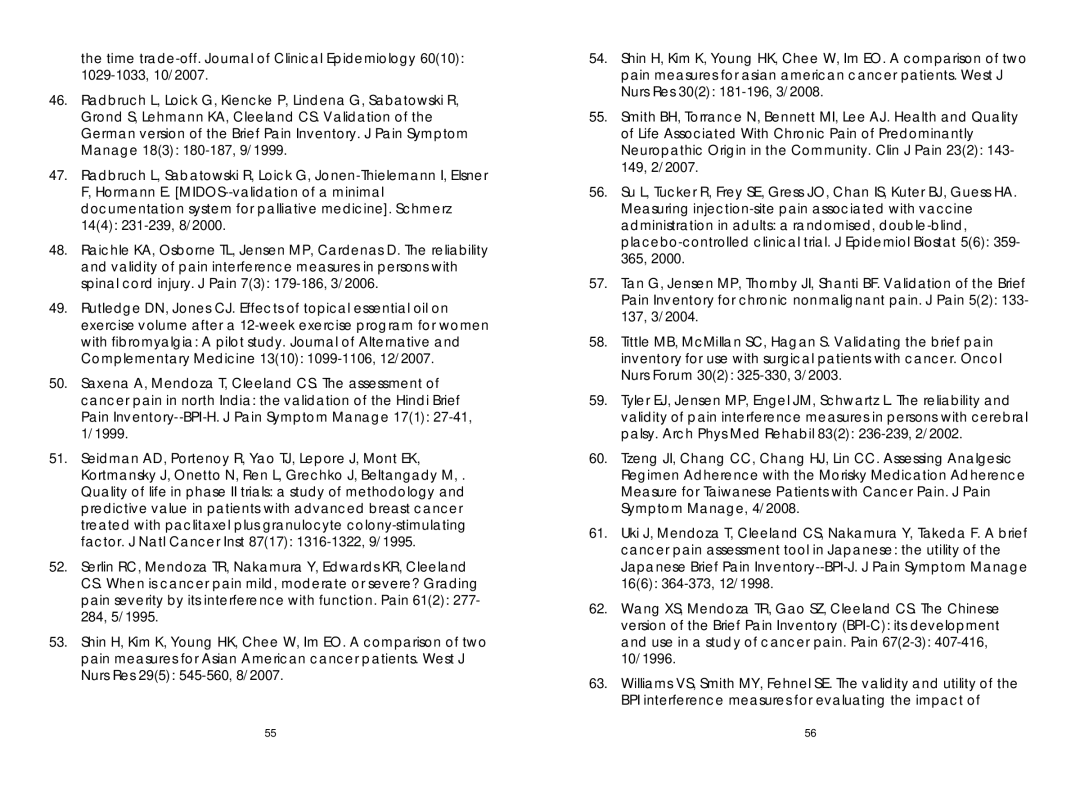the time
46.Radbruch L, Loick G, Kiencke P, Lindena G, Sabatowski R, Grond S, Lehmann KA, Cleeland CS. Validation of the German version of the Brief Pain Inventory. J Pain Symptom Manage 18(3):
47.Radbruch L, Sabatowski R, Loick G,
48.Raichle KA, Osborne TL, Jensen MP, Cardenas D. The reliability and validity of pain interference measures in persons with spinal cord injury. J Pain 7(3):
49.Rutledge DN, Jones CJ. Effects of topical essential oil on exercise volume after a
50.Saxena A, Mendoza T, Cleeland CS. The assessment of cancer pain in north India: the validation of the Hindi Brief Pain
51.Seidman AD, Portenoy R, Yao TJ, Lepore J, Mont EK, Kortmansky J, Onetto N, Ren L, Grechko J, Beltangady M, . Quality of life in phase II trials: a study of methodology and predictive value in patients with advanced breast cancer treated with paclitaxel plus granulocyte
52.Serlin RC, Mendoza TR, Nakamura Y, Edwards KR, Cleeland CS. When is cancer pain mild, moderate or severe? Grading pain severity by its interference with function. Pain 61(2): 277- 284, 5/1995.
53.Shin H, Kim K, Young HK, Chee W, Im EO. A comparison of two pain measures for Asian American cancer patients. West J Nurs Res 29(5):
54.Shin H, Kim K, Young HK, Chee W, Im EO. A comparison of two pain measures for asian american cancer patients. West J Nurs Res 30(2):
55.Smith BH, Torrance N, Bennett MI, Lee AJ. Health and Quality of Life Associated With Chronic Pain of Predominantly Neuropathic Origin in the Community. Clin J Pain 23(2): 143- 149, 2/2007.
56.Su L, Tucker R, Frey SE, Gress JO, Chan IS, Kuter BJ, Guess HA. Measuring
57.Tan G, Jensen MP, Thornby JI, Shanti BF. Validation of the Brief Pain Inventory for chronic nonmalignant pain. J Pain 5(2): 133- 137, 3/2004.
58.Tittle MB, McMillan SC, Hagan S. Validating the brief pain inventory for use with surgical patients with cancer. Oncol Nurs Forum 30(2):
59.Tyler EJ, Jensen MP, Engel JM, Schwartz L. The reliability and validity of pain interference measures in persons with cerebral palsy. Arch Phys Med Rehabil 83(2):
60.Tzeng JI, Chang CC, Chang HJ, Lin CC. Assessing Analgesic Regimen Adherence with the Morisky Medication Adherence Measure for Taiwanese Patients with Cancer Pain. J Pain Symptom Manage, 4/2008.
61.Uki J, Mendoza T, Cleeland CS, Nakamura Y, Takeda F. A brief cancer pain assessment tool in Japanese: the utility of the Japanese Brief Pain
62.Wang XS, Mendoza TR, Gao SZ, Cleeland CS. The Chinese version of the Brief Pain Inventory
63.Williams VS, Smith MY, Fehnel SE. The validity and utility of the BPI interference measures for evaluating the impact of
55 | 56 |
